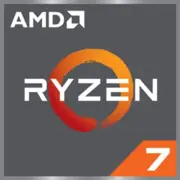AMD Ryzen 7 1700X

AMD Ryzen 7 1700X in 2025: Is It Worth Getting a Legend from the Past?
Relevant Analysis for Budget Enthusiasts and Workstations
Key Specifications: Architecture and Key Features
The AMD Ryzen 7 1700X, released in 2017, was one of the first "killers" of Intel in the multi-core CPU segment. Despite its age, in 2025 it maintains niche relevance thanks to its unique specifications:
- Zen Architecture (Summit Ridge): The first generation of Zen revolutionized multi-threaded performance. It has 8 cores and 16 threads based on GlobalFoundries' 14nm process technology.
- Frequencies: Base clock — 3.4 GHz, turbo mode — 3.8 GHz. Sufficient for stock operations, but overclocking to 4.0 GHz is possible with good cooling (user experiences suggest a performance boost of +10-15%).
- Cache: 16 MB L3 — adequate for rendering tasks and multitasking.
- TDP 95W: Energy efficiency is higher than many modern counterparts.
- Geekbench 6: 1079 (single-core), 5542 (multi-core). Performance is close to the Intel Core i5-10400, but with double the number of threads.
Key Features of 2025:
- Price — around $60-80 for new remnants (refurbished models).
- Support for ECC memory (relevant for NAS and workstations).
- Low thermal output for builds in compact cases.
Compatible Motherboards: Sockets and Chipsets
The Ryzen 7 1700X uses the AM4 socket, providing access to a vast selection of motherboards. However, in 2025, new AM4 boards are no longer being produced — look for stock or used options:
- Chipsets:
- X370/B350: Basic options with overclocking support (ASUS Prime X370-Pro, MSI B350 Tomahawk).
- X470/B450: More stable and functional options (e.g., ASRock X470 Taichi).
- A520/X570: Theoretically compatible but require a BIOS update (check support lists!).
Choosing Tips:
- For overclocking, choose boards with reliable VRM (minimum 6 phases). For example, the Gigabyte AX370-Gaming 5.
- Avoid cheap A320 boards as they limit CPU potential.
- Ensure the BIOS is updated to the version with AGESA 1.0.0.6 or newer.
Memory: DDR4 and Hidden Limitations
The Ryzen 7 1700X works only with DDR4. No support for DDR5, which is a major downside for upgrades in 2025.
- Official frequency: Up to 2666 MHz (without overclocking).
- Recommendations:
- Use dual-channel kits (2×8 GB or 2×16 GB).
- Optimal frequencies are 2933–3200 MHz (requires manual overclocking via XMP).
- Best timings: CL14–CL16 (e.g., G.Skill Ripjaws V 3200 MHz CL16).
Important: Early Zen chips are sensitive to memory quality. Avoid cheap no-name modules — errors may occur.
Power Supply: How Many Watts Do You Need?
With a TDP of 95W, the Ryzen 7 1700X isn't demanding on power, but consider the discrete graphics card:
- Minimum: 500W (for systems with GPU level NVIDIA GTX 1660).
- Recommended range: 550–650W (for RTX 3060 or RX 6600 XT).
- Power Supply Examples:
- Budget: Corsair CX550M (80+ Bronze, $65).
- Quiet: Be Quiet! System Power 10 600W (80+ Bronze, $75).
- Reliability: Seasonic Focus GX-650 (80+ Gold, $110).
Tip: Don’t skimp on the power supply! Cheap models (e.g., Aerocool KCAS) may operate unstably under load.
Pros and Cons in 2025
Advantages:
1. Price/Performance: The best choice for budget workstations ($60-80 compared to $200 for Ryzen 5 7600).
2. Multi-threading: 16 threads are relevant for rendering in Blender or video encoding.
3. Energy Efficiency: Consumes less than modern Core i7/i9.
4. Compatibility: Supports Windows 10/11 and Linux (kernel 5.15+).
Disadvantages:
1. Outdated Architecture: IPC is 40% lower than Zen 4.
2. No PCIe 4.0/5.0: Maximum — PCIe 3.0 (limits SSD and GPU).
3. Upgrade Challenges: AM4 is no longer being developed.
4. No Integrated Graphics: Requires a discrete graphics card.
Use Cases: Where It Still Excels
- Work Tasks:
- Video editing in DaVinci Resolve (utilizes 90-95% of cores).
- 3D rendering (for example, rendering a scene in Cinema 4D on 16 threads is twice as fast as on a 4-core i7).
- Virtualization (VMware, Docker).
- Gaming:
- Older titles (Cyberpunk 2077 on medium settings + GTX 1080 — 45-55 FPS).
- Modern online games (Fortnite, Apex Legends — 70-90 FPS with RTX 3060).
- Issues: Minimum FPS is lower than with Ryzen 5 5600X due to weak IPC.
- Multimedia:
- Streaming via OBS (x264 Medium — 720p@60 without lag).
- Home server (Plex, file storage).
Competitors: Who to Compare With?
1. Intel Core i7-7700K (4C/8T):
- Pros: Better gaming performance (Geekbench 6 Single-Core: 1250).
- Cons: In 2025, 4 cores are insufficient for multitasking.
2. Ryzen 5 5600X (6C/12T):
- Pros: Zen 3, IPC is 20% higher, supports PCIe 4.0.
- Cons: More expensive ($120-150), fewer threads.
3. Intel Core i5-12400F (6C/12T):
- Pros: Energy efficiency, DDR5.
- Cons: Higher price ($160), requires a new motherboard.
Conclusion: The Ryzen 7 1700X excels in multi-threaded tasks but lags in gaming and “heavy” applications.
Assembly Tips
1. Motherboard: Look for models with USB 3.1 Gen2 and M.2 (e.g., ASUS ROG Strix B450-F Gaming II).
2. Cooling: Even a budget Deepcool Gammaxx 400 V2 would suffice (load temperatures — up to 75°C).
3. Memory: 32 GB DDR4-3200 is optimal for 4K editing.
4. SSD: Samsung 970 Evo Plus (PCIe 3.0 x4) — won’t hit CPU limitations.
5. Graphics Card: RTX 3060 or RX 6600 XT — balance without bottlenecks.
Conclusion: Who Should Consider the Ryzen 7 1700X in 2025?
This processor is worth considering for:
- Budget Workstations: Editing, rendering, virtualization.
- Upgrading Old PCs: If you have a compatible motherboard and DDR4.
- Enthusiasts: Experiments with overclocking and building “retro PCs”.
Why Not? If you need modern games on Ultra settings or work with neural networks — it's better to go for Ryzen 5 7600 or Core i5-13400F. But at $60-80, the Ryzen 7 1700X remains the king of budget for less demanding tasks.
Basic
CPU Specifications
Memory Specifications
GPU Specifications
Miscellaneous
Benchmarks
Compared to Other CPU
Share in social media
Or Link To Us
<a href="https://cputronic.com/index.php/cpu/amd-ryzen-7-1700x" target="_blank">AMD Ryzen 7 1700X</a>